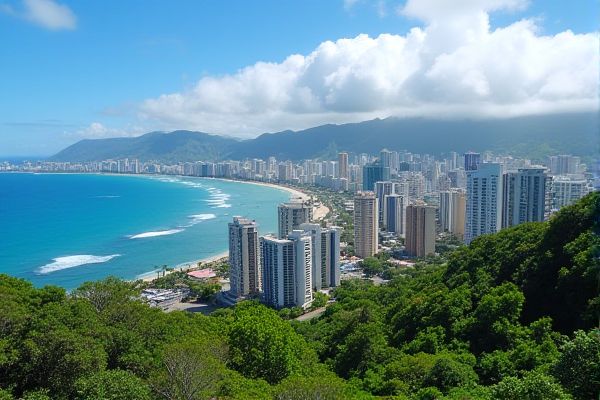
Transportation and commuting in Hawaii: Limited public transportation options. High reliance on personal vehicles. Island ferry services available. Traffic congestion in urban areas. Car rental recommended for tourists. Bus service in major cities. Biking infrastructure improving. Hawaiian islands not interconnected by bridges. Ride-sharing services available. Regional airports for inter-island travel.
Limited public transportation options.
While Hawaii's Big Island offers free public transit via the Hele-On Bus with extensive routes, other islands have more limited public transportation options, with some islands like Lanai and Molokai having no municipal bus services. Additionally, the state's transportation system faces challenges such as increasing vehicle travel, worsening traffic conditions, and a need for a shift in spending priorities to support alternative transportation methods.
High reliance on personal vehicles.
Hawaii has a high reliance on personal vehicles, with 80.9% of workers using cars to commute to work, and the annual cost of vehicle ownership estimated at $8,100 per vehicle or $16,200 per household for those owning two or more cars. This dependency on personal vehicles reflects significant economic and social impacts, as highlighted in a recent report examining Hawaii's $21.8 billion vehicle economy. The findings underscore the critical need to explore alternative transportation solutions to alleviate the financial burden on households and address environmental concerns.
Island ferry services available.
In Hawaii, there is no statewide inter-island ferry system, but there are specific ferry services available, such as the Maui-Lanai ferry operated by Expeditions, and the Molokai Ferry between Molokai and Maui. These ferries provide passenger service but do not transport vehicles, unlike the now-defunct Hawaii Superferry that briefly operated between Oahu, Maui, and other islands from 2007 to 2009. For more information, you can visit the Maui Travel Blog on Howzit Hostels' website.
Traffic congestion in urban areas.
Traffic congestion in Honolulu, despite dropping in national rankings due to expanded and more accurate measurement methods, remains severe, particularly on the H-1 freeway and in areas like Salt Lake to Chinatown and McCully to Kahala, where commute times are significantly longer during rush hours. For more detailed insights, you can refer to the article on Honolulu Traffic by Civil Beat, which explains the shifts in rankings and ongoing challenges faced by commuters in the city. As efforts continue to address this critical issue, residents hope for eventual improvements in traffic flow.
Car rental recommended for tourists.
Renting a car in Hawaii is highly recommended for tourists, especially on the Neighbor Islands, as it provides the most flexibility and ease in exploring the islands, given the limited public transportation options and the vast areas to cover. For more detailed guidance on this subject, you can visit the Hawaiian Airlines Trip Planning Guide to make the most out of your visit to the islands.
Bus service in major cities.
TheBus is the public bus transportation service on the island of O`ahu, Hawaii. Operating 115 routes with a fleet of 518 buses and 207 paratransit vehicles, it serves Honolulu County with a daily ridership of 131,200. Other islands, such as Maui, Hawaii, and Kauai, have their own public bus systems, including Maui Bus with 12 routes and Hele-On on the Island of Hawaii, each providing comprehensive public transit services. For more detailed information on routes and schedules, visit the official page for TheBus.
Biking infrastructure improving.
Hawaii is undertaking significant efforts to improve biking infrastructure, including a planned 30-mile bike path from Nanakuli to Manoa, which could take up to 20 years to complete. This ambitious project involves extensive planning, environmental studies, and community outreach to create a safer and more comprehensive network for cyclists and pedestrians. For further details, you can explore more at the Civil Beat website.
Hawaiian islands not interconnected by bridges.
The Hawaiian Islands are not interconnected by bridges, so travelers must rely on other transportation methods to explore multiple islands. The primary options for island hopping include flying with airlines such as Hawaiian Airlines, Southwest Airlines, and Mokulele Airlines. Another method is taking a ferry; however, the only current ferry service operates between Maui and Lanai. For more detailed information on how to navigate between these beautiful islands, visit the comprehensive guide on [Hawaii Island Hopping](https://thehawaiivacationguide.com/hawaii-island-hopping/).
Ride-sharing services available.
Holoholo is a locally owned rideshare service in Hawaii, providing convenient and affordable transportation across Oahu, Maui, Hawaii Island, Kauai, and Lanai. It offers options to book rides either in advance or at the last minute, ensuring flexibility for all travelers. A standout feature of Holoholo is its commitment to safety with vaccinated drivers, along with the assurance of no surge pricing at airports. Whether you're planning your journey or need a ride on the spot, Holoholo ensures a reliable experience. Discover more about their services at Holoholo.
Regional airports for inter-island travel.
For inter-island travel in Hawaii, key regional airports include Honolulu International (HNL), Kahului (OGG) on Maui, Lihue (LIH) on Kauai, Kona (KOA), and Hilo (ITO) on the Big Island. Airlines such as Hawaiian Airlines, Southwest Airlines, and Mokulele Airlines operate flights between these airports, with Hawaiian Airlines being the dominant carrier and offering the most extensive network.
